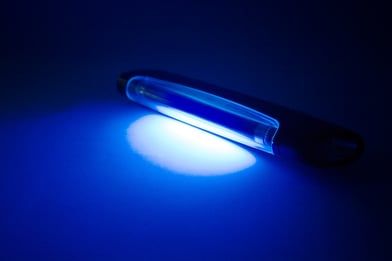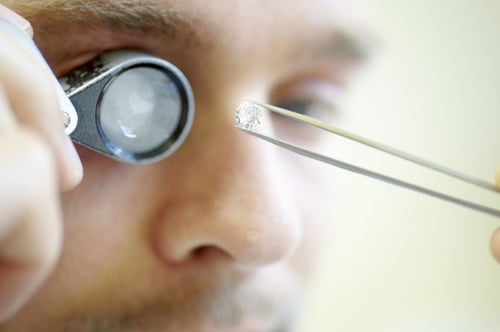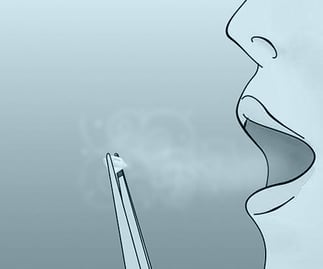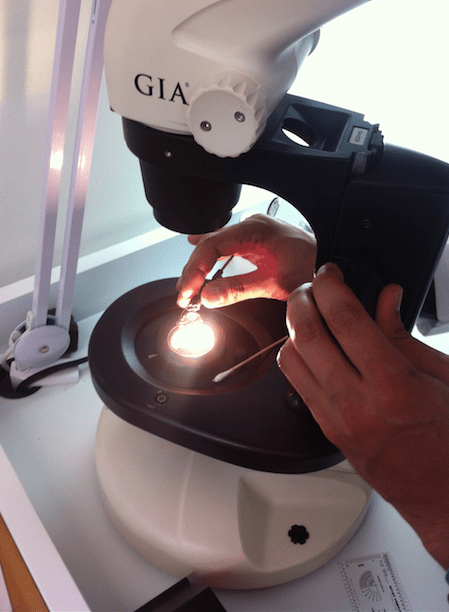Diamonds, be it colorless or colored, are all assets to be admired. They are so rare, mesmerizing, and breathtaking that we often spend thousands or even millions to acquire them. The question is, how do we know that the asset we invested our money in is genuine (assuming we don't have a certification)? How can we tell we own a real diamond?
In this post, we will be going over how to assess if a diamond is truly natural, or a synthetic "impostor."
We will be splitting the post into to two segments. The first will be going over ways you can test if you have a real diamond on your own, while the second will include some more "professional" test carried out by gemologist and trained professionals.
Here are just a few of the questions we will be answering in this post:
- Will a Real Diamond Sink or Float?
- How to Tell If A Diamond Is Real By Using Your Breath?
- Can You Tell Your Diamond Is Real Using the Setting Test?
- Will a Real Diamond Break Under Intense Heat?
- Can You Tell a Diamond Is Real Using Refractivity?
- Can You Tell a Diamond Is Real Using a Newspaper?
- Can You Tell a Diamond Is Real Using Reflectivity?
- Can You Tell a Diamond Is Real Using UV Light?
- How To Tell a Diamond Is Real Using a Loupe?
- How To Tell a Diamond Is Real Using a Microscope?
So how can you test if your diamonds are real or fake from the comfort of your own home?
Will a Real Diamond Sink or Float?
How to Tell If A Diamond Is Real By Using Your Breath?
You can often tell if a diamond is real by breathing on it. Real diamonds are excellent conductors of heat, this means that they can disperse heat very quickly. Knowing this; lift your diamond with a pair of tweezers (if it is loose, if not just hold the ring or piece of jewelry with your fingers) and gently breathe on the stone. If the fog takes a few seconds to disperse, then the gem is likely fake, conversely, if the fog gets dispersed almost immediately then the diamond is real.
How to Tell a Diamond Is Real Using the Setting Test
This test only applies to diamonds that have been set in a piece of jewelry (most commonly a ring.) While this may be an "indirect" test, it can often be used to supplement the rest of the methods in this post (again assuming that the diamond is set, and not loose).
Due to their high value, real diamonds are usually set in high-quality jewelry such as platinum, gold, and white gold. In order to check if the stone’s setting is truly of such quality, check the inside of the ring’s center for a descriptive engagement.
- 10K, 14K, and 18K all are indicators of quality of gold
- PT and Plat refer to platinum
- Numbers including 585, 770, 900, and 950 can also indicate quality for either gold or platinum
However, if C.Z. is present, the gem is actually cubic zirconium and not a real diamond.
Will a Real Diamond Break Under Intense Heat?
A real diamond will not break under intense heat. Diamonds are formed under instances of intense heat and massive pressure. It is because of this, that their molecular structure is extremely strong and resilient.
If the diamond is loose, pick it up with pliers or metallic tweezers (for your own safety you might want to do this wearing gloves and preferably outside) and heat the gem over a flame for about a minute. Then quickly drop the stone into a glass or container with cold water. If the stone fractures or shatters because of the quick and drastic change of temperature, it is not a real diamond.
How to Tell if a Diamond is Real Using Refractivity
You can tell a real diamond apart from a fake one by observing its refractivity. Diamonds, especially colorless ones, are known for their ability to excellently and beautifully refract light, this is known as brilliance.
Shine a light on to your diamond and pay close attention to how the light enters through the gem’s pavilions (located on the lower half), and how it is refracted throughout the body and its table (the flat surface of the diamond on the top.) The intense sparkle, pattern, and beauty are almost impossible to mimic in anything other than a truly natural diamond.
Other types of gems such as cubic zirconium, do not have the ability to refract light as well (if at all.)
Can You Tell if a Diamond is Real By Using a Newspaper?
You can actually test if a diamond is real using the newspaper test. This is a simple one; all you have to do is take the diamond (assuming it is loose) and place it onto a page of a newspaper (or any other book, magazine, even an electrical bill, or bank statement, as long as the letters are small enough to fit under the stone) with its flat side down. Next, make sure that there is plenty of light and that nothing is casting a shadow on the stone. If you are able to read the letters below, the gem is not a real diamond.
Like we said before, real diamonds refract light in multiple different directions, this would cause the letters below the diamond look distorted and illegible.
How to Tell if a Diamond is Real Using Reflectivity
You can tell a real diamond apart from a fake one by observing its reflectivity. The reflectivity of diamonds includes:
- Brilliance: White light sparkle
- Fire: Colored light
Here you don’t need anything intricate, just a source of light. Hold the diamond under a normal lamp in your home and pay attention to how the light is reflected off the stone. A real diamond will reflect both types of light extremely well and in magnificent patterns, in a way that no other substance can replicate.
Can You Tell if a Diamond is Real Using UV Light?
You can tell a diamond is real by using UV light. To test this, place your diamond under a UV light and watch the reaction. Most diamonds will emit a blue colored glow, but it should be noted that all diamonds react the same way. Some diamonds do not glow under UV light. For this reason, if the stone does not glow, the results don’t necessarily indicate that it’s a fake diamond.

Because this test is not definitive, it’s best to have a diamond expert or jeweler use their advanced equipment to test the stone.
And there you have it. Now note that while this guide is useful and practical, no single at-home test should be regarded as conclusive. A diamond expert has the proper experience and equipment to confirm if a diamond is real or fake.
With the above in mind, there are only so many tests you can carry out yourself. While convenient, most of these test are not conclusive, and to the untrained eye there is much room for error.
These were a few methods you could carry out on your own at home to see if your diamond is likely real or not. But how do the professionals do it?
How to Tell if a Diamond is Real Using Professional Methods
If you want to be 100% certain for your diamond's authenticity, the best thing you can do is seek the expertise of a seasoned gemologist.
So what methods do the experts use to test for authenticity, and what can we learn from them?
How to Tell a Diamond is Real Using a Loupe
The first thing any gemologist or diamond expert will do when evaluating a gem is to look at it through a Loupe. Loupes are special magnifying glasses specifically made for assessing diamonds, jewelry, and other kinds of gemstones.
These devices are used to locate small imperfections in a diamond's crystal lattice. While it might not look like it on the outside, most diamonds are not perfect and are none are identical. Much like humans, they carry a unique fingerprint, or pattern, that sets them apart, and often times come with very slight internal imperfections. A gem that is 100% clear of all the above is usually not an authentic diamond.

How to Tell a Diamond is Real Using a Thermal Conductive Probe
The thermal conductivity probe or meter, also known as the “diamond tester” does exactly what its name implies; it tests the heat conductivity of a stone. If you remember from our "test it yourself" segment of the article, diamonds are excellent heat conductors and will disperse heat rapidly after being warmed. If the heat is dispersed quickly, then the diamond is real, if however the heat is dispersed slowly, it is not.
While this might sound straightforward, it is actually not entirely conclusive. There are other, synthetic stones such as moissanite that might oftentimes have similar or identical conductivity to real diamonds. So further testing might be needed in order to distinguish these two types of gems, in the lab.
How to Tell a Diamond is Real Using The Electric Conductivity Test
In addition to being excellent heat conductors, diamonds are also great at conducting electricity. This test is usually a follow-up to the thermal conductive probe test in order to distinguish between moissanite stones. Contrary to the above, moissanite gems are not as good as conducting electricity as they are with heat.
Bonus: How to Test for Real Diamonds vs Moissanite Diamonds
Technology has advanced so much in our times that the ability to create synthetic and affordable stones that are identical to real diamonds is now a reality. With more and more of these stones emerging, and bigger players starting to produce them (such as De Beers) it is only logical that we would want to determine if our stones are 100% authentic or synthetic. Again, these tests can only be carried out by certified gemologists in labs. So how do they do it?
How to Test for Real Diamonds using Microscopic Examination
With the help of powerful microscopes that can magnify an image to 1200x, gemologists (and jewelers) are able to examine the gem in intense detail. This allows them to find any inclusions or minute characteristics found only in a real diamond.
How to Tell a Diamond is Real Using Using X-Rays
Another test that can only be performed in specialized labs is the x-ray test. Here, the exposure will be able to tell gemologists if the stone has a radiolucent molecular structure (a trait found in real diamonds) or a radiopaque molecular structure (found in synthetics, cubic zirconium, etc.)
While there are numerous ways to tell if your diamond is real or not, always request certification for the diamond you are about to buy. Be sure its from a well known institute such as the GIA or the AGS. This will not only offer you some piece of mind by knowing that your diamond is in fact real, it will also make reselling your diamond much easier, if you ever chose to do so.
Did you have any questions? Is there something you want us to add more detail to? Is there something we missed? Let us know! And as always feel free to follow us on Twitter and LinkedIn.
To read more about the most famous colored diamonds in the world, see the link below:
- 3 Key Insights Driving Fancy Colored Diamonds Investments
- Colored Diamonds Growing as an Alternative Investment
- Pink Diamonds Show Largest Growth of Colored Diamonds
- Investing in Natural Pink Diamonds: What You Need to Know
- Alternative Investments: A Comparison of Commodity Investing






